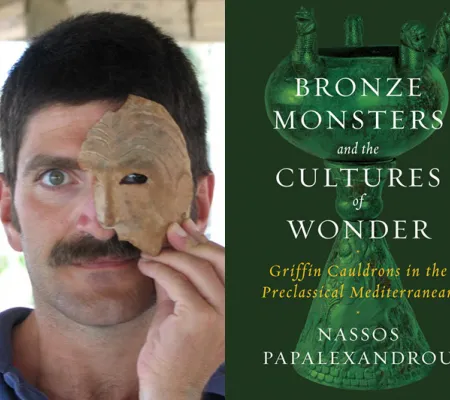Recently published by UT Press, Art History Associate Professor Nassos Papalexandrou’s book Bronze Monsters and the Cultures of Wonder explores griffin cauldrons in the preclassical Mediterranean (seventh and eight centuries). The cauldrons included handle-attachments in the form of griffin protomes and were a major import to the Mediterranean. Bronze Monsters and the Cultures of Wonder allows Papalexandrou to use the griffin cauldrons as case studies to argue that griffins were believed to be realistic.
The Department of Art and Art History spoke with Papalexandrou about working on the project for almost ten years, where griffins fit into the world of mythological monsters, and advice for current art history students.
AAH: What inspired you to first set out to write this book?
Dr. Nassos Papalexandrou: I am fascinated by the time period (7th c. BCE), which is one of expanding physical and cognitive horizons and intense mobility of people, objects and ideas all around the Mediterranean. Like other similar periods (e.g. Early Modernity or southwest Asia in the aftermath of Alexander the Great’s conquests), the 7th century was a time of wonders. I explore this in depth in my book.
AAH: Why were griffin cauldrons the specific piece you focused this case study on?
NP: Griffin cauldrons are visually, materially and technically extraordinary. Unfortunately, almost always they survive in fragments. In my project I undertook to notionally put the fragments together in order to explore their physical qualities (e.g. sensory) and functions in context. I am particularly interested in their users’ or viewers’ responses to them.
AAH: Since these cauldrons were viewed by the elite, how accurate of a picture can we create about the ancient world?
NP: It is a positivist myth that we could ever create an accurate picture of the ancient world. We get glimpses of aspects of experience, which we have to reconstruct with great care and sensitivity so as not to project our own implicit or explicit agendas on past eras and people.
AAH: How does this case study relate to the art world on a grander scale, where art might still be exclusionary to some people?
NP: What we call “art” has not always been cognitively or physically accessible to anybody—art history and archaeology often ignore or sweep aside this aspect of intricate artifacts’ or “artworks’” ancient lives. Various institutions (state, church, etc) have always exploited people’s lack of the appropriate interactive “software” with works of art or “art.”
AAH: Why is it that in 7th/8th centuries BCE we see more mythological monsters in the Mediterranean, and why didn’t this continue?
NP: In eras of sudden explosion in geographical knowledge, the world needs to be remapped physically and cognitively. Monsters express our incapacity to deal with novel perceptions of scale and distance, as well as novel and often unsettling social relationships that derive from the cognitive recalibration entailed by an ever-expanding cosmos.
AAH: Where do you see griffins fitting into the realm of monsters?
NP: I strongly argue in my book that griffin cauldrons were perceived as multi-bodied monsters in certain environments (e.g. sanctuaries in Greece, elite funeral contexts in pre-roman Italy). Unlike other monsters of early narratives (e.g. sphinx, chimaera, etc), griffins were never defeated by a hero (e.g. like Oedipus, the slayer of the Theban Sphinx; Bellerophon, the slayer of Chimaira; Hercules, the slayer of Hydra). The lifelikeness of griffins in griffin cauldrons made people respond to them as if they were real monsters.
AAH: What is the process behind gaining access to these pieces and identifying which cauldrons you needed to see?
NP: Griffin cauldrons are archaeologically attested in an area stretching from Cyprus and southwest Turkey to Northern France (Burgundy). It took me years to visit all the museums in which remnants of griffin cauldrons are stored or on display. Most are in several museums in Greece and Italy. I made a point of examining in person as many cauldrons and bronze griffins as possible. Authorities in many countries facilitated my research, provided access, permissions for photographs, etc.
AAH: How long did this project take, and since it was years in the making, how does it feel to be done?
NP: It took me about ten years, during which I also focused on other interests (e.g. museological; also my current book-project on antiquities as diplomatic gifts, which at times run concurrently with the Bronze Monsters one). Though I enjoyed every moment of my research, by the end of my work on this book I was ready to switch my attention to other research interests. However, I am still working on shorter articles on aspects of griffin cauldrons, the discussion of which was not possible in my book.
AAH: Do you have any advice for people working on large projects; what kept you going?
NP: What kept me going was that this project provided me with an opportunity to engage seriously with new aspects of art history and archaeology. The most powerful stimulant is always the thrill of new discoveries and new knowledge.


